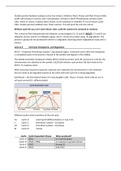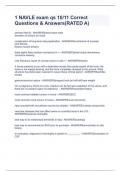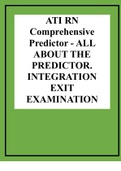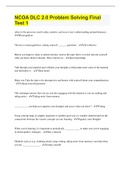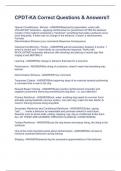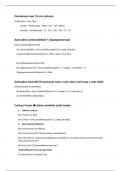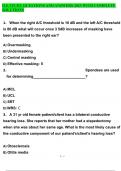Oncogenesis Week 1
Lecture 1
Second messengers are produced inside of
the cell.
Kinases phosphorylate substrates to
activate them. It uses ATP → ADP for this
reaction.
GTPase bound to GDP is inactive/off,
GTPase bound to GTP is active/on.
G-protein receptor, phospholipase-C,
calcium, activation of protein kinases.
→ See PLC.
Nf-kb is an important transcription factor
that can go into the nucleus.
Receptor tyrosine kinases need
dimerization for their activation. They
undergo a conformational change and they
start to cross-phosphorylate.
Phosphorylated tyrosine residues →
activated receptor (ligand is a growth
factor).
SH2 domains → high affinity for
phosphorylated tyrosine residues.
RAS is active if it’s bound to GTP rather than GDP (inactive). GTP Exange Protein (GEP) activates RAS.
GAP = GTPase (GTP → GDP hydrolysis) activating protein → helps Ras to become inactive. Grb2 x SOS
molecule has 1 SH2 and 2 SH3 domains → this recruits Ras. Ras recruits Raf. Raf phosphorylates MEK
and MEK phosphorylates MAPK.
Raf = MAP-kinase-kinase-kinase, MEK = MAP-kinase-kinase, MAPK =MAP-kinase
, Grb2xSOS recruits
inactive RAS
Phospholipase C (PLC) is activated
by both G-protein coupled receptors
AND by Receptor tyrosine kinases
→ cross-talk between the pathways.
PLC catalyses:
PIP2 → IP3 + DG (DiacylGlycerol).
PI3K is another kinase → PIP3 (phospholipid) production in the membrane → recruits PH domains of
PDK1 and PKB. PBK can phosphorylate BAD → inhibition of apoptosis ➔ Survival pathway.
, Src = sarc/sarcoma. This src gene is highly similar to the human gene for a protein kinase (tyrosine).
Proto-oncogenes are normal genes that can become oncogenes by gene mutations / amplification /
translocation / insertional mutagenesis.
Bcr/abl gene is constantly active (fusion protein → chromosomal translocation). Bcr gene on
chromosome 22, abl gene on chromosome 9.
Overexpression of Bcl-2 = anti-apoptotic.
Oncogene = gain of function. Tumor suppressor gene = loss of function.
Retinoblastoma (eye cancer, Rb) controls the cell cycle and it is a tumor suppressor gene. Loss of
function (mutated in both alleles) results in an uncontrolled cell cycle.
Colorectal cancer due to defects in Wnt signalling. B-catenin is an oncogene. If it’s not degraded it
will be present in high numbers. Hereditary mutations in APC (TSG in Wnt signaling pathway) results
in FAP (polyps).
NF-1 deactivates RAS (tumor suppressor gene). Small molecule inhibitors and antibody therapy are
two cancer therapies that are used often lately.
Hereditary cancer: almost exclusively TSG mutations (oncogenic mutations are embryonic lethal).
P53 blocks initiation of DNA synthesis and/or initiates apoptosis and is therefore both an TSG as an
oncogene.
Lecture 2 Hallmarks of Cancer
1. Self-sufficiency of growth signals (sustaining proliferative signalling)
cell proliferation without the need of external growth factors.
2. Insensitivity to anti-growth signals (evading growth-suppressors)
Loss of cadherins or … → Loss of tumor suppressors (2-hit event) → continued proliferation
Anti-growth signals: oncogenic signalling, glucose, DNA damage, ROS, lack of nucleotides.
These signals go through TP53 (tumor suppressor gene P53).
3. Evading apoptosis
Loss of pro-apoptotic proteins and increased survival signals → Survival.
4. Limitless replicative potential
Telomeres are ends of chromosomes. End replication problem. Loss of DNA. Anytime you have a
cell division you’ll lose a bit of your chromosome. Telomere shortening. Eventually you’ll damage
your DNA.
Telomere extension by telomerase. Reverse transcription with a RNA primer. Especially within
germ line cells.
Telomerase reactivation → immortality
5. Sustained angiogenesis
Cancer doesn’t naturally have this. New vessels to the tumour. VEGF is a ligand for a receptor
tyrosine kinase that activates this process. Pro-angiogenic signals → vascularization (formation of
new blood vessels).
Lecture 1
Second messengers are produced inside of
the cell.
Kinases phosphorylate substrates to
activate them. It uses ATP → ADP for this
reaction.
GTPase bound to GDP is inactive/off,
GTPase bound to GTP is active/on.
G-protein receptor, phospholipase-C,
calcium, activation of protein kinases.
→ See PLC.
Nf-kb is an important transcription factor
that can go into the nucleus.
Receptor tyrosine kinases need
dimerization for their activation. They
undergo a conformational change and they
start to cross-phosphorylate.
Phosphorylated tyrosine residues →
activated receptor (ligand is a growth
factor).
SH2 domains → high affinity for
phosphorylated tyrosine residues.
RAS is active if it’s bound to GTP rather than GDP (inactive). GTP Exange Protein (GEP) activates RAS.
GAP = GTPase (GTP → GDP hydrolysis) activating protein → helps Ras to become inactive. Grb2 x SOS
molecule has 1 SH2 and 2 SH3 domains → this recruits Ras. Ras recruits Raf. Raf phosphorylates MEK
and MEK phosphorylates MAPK.
Raf = MAP-kinase-kinase-kinase, MEK = MAP-kinase-kinase, MAPK =MAP-kinase
, Grb2xSOS recruits
inactive RAS
Phospholipase C (PLC) is activated
by both G-protein coupled receptors
AND by Receptor tyrosine kinases
→ cross-talk between the pathways.
PLC catalyses:
PIP2 → IP3 + DG (DiacylGlycerol).
PI3K is another kinase → PIP3 (phospholipid) production in the membrane → recruits PH domains of
PDK1 and PKB. PBK can phosphorylate BAD → inhibition of apoptosis ➔ Survival pathway.
, Src = sarc/sarcoma. This src gene is highly similar to the human gene for a protein kinase (tyrosine).
Proto-oncogenes are normal genes that can become oncogenes by gene mutations / amplification /
translocation / insertional mutagenesis.
Bcr/abl gene is constantly active (fusion protein → chromosomal translocation). Bcr gene on
chromosome 22, abl gene on chromosome 9.
Overexpression of Bcl-2 = anti-apoptotic.
Oncogene = gain of function. Tumor suppressor gene = loss of function.
Retinoblastoma (eye cancer, Rb) controls the cell cycle and it is a tumor suppressor gene. Loss of
function (mutated in both alleles) results in an uncontrolled cell cycle.
Colorectal cancer due to defects in Wnt signalling. B-catenin is an oncogene. If it’s not degraded it
will be present in high numbers. Hereditary mutations in APC (TSG in Wnt signaling pathway) results
in FAP (polyps).
NF-1 deactivates RAS (tumor suppressor gene). Small molecule inhibitors and antibody therapy are
two cancer therapies that are used often lately.
Hereditary cancer: almost exclusively TSG mutations (oncogenic mutations are embryonic lethal).
P53 blocks initiation of DNA synthesis and/or initiates apoptosis and is therefore both an TSG as an
oncogene.
Lecture 2 Hallmarks of Cancer
1. Self-sufficiency of growth signals (sustaining proliferative signalling)
cell proliferation without the need of external growth factors.
2. Insensitivity to anti-growth signals (evading growth-suppressors)
Loss of cadherins or … → Loss of tumor suppressors (2-hit event) → continued proliferation
Anti-growth signals: oncogenic signalling, glucose, DNA damage, ROS, lack of nucleotides.
These signals go through TP53 (tumor suppressor gene P53).
3. Evading apoptosis
Loss of pro-apoptotic proteins and increased survival signals → Survival.
4. Limitless replicative potential
Telomeres are ends of chromosomes. End replication problem. Loss of DNA. Anytime you have a
cell division you’ll lose a bit of your chromosome. Telomere shortening. Eventually you’ll damage
your DNA.
Telomere extension by telomerase. Reverse transcription with a RNA primer. Especially within
germ line cells.
Telomerase reactivation → immortality
5. Sustained angiogenesis
Cancer doesn’t naturally have this. New vessels to the tumour. VEGF is a ligand for a receptor
tyrosine kinase that activates this process. Pro-angiogenic signals → vascularization (formation of
new blood vessels).


